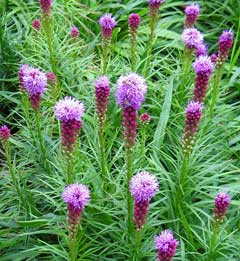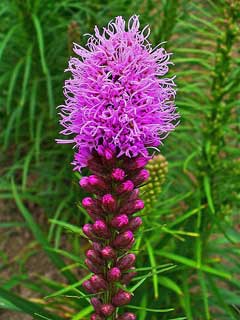 |
|
http://commons.wikimedia.org/wiki/User:MJJR |
 |
| http://commons.wikimedia.org/wiki/User:Llez |
Translate this page:
Summary
Bloom Color: White. Main Bloom Time: Early fall, Late summer, Mid summer. Form: Upright or erect.
Physical Characteristics

 Liatris spicata is a PERENNIAL growing to 0.6 m (2ft) by 0.3 m (1ft in) at a medium rate.
Liatris spicata is a PERENNIAL growing to 0.6 m (2ft) by 0.3 m (1ft in) at a medium rate.
See above for USDA hardiness. It is hardy to UK zone 3. It is in flower in September, and the seeds ripen in October. The species is hermaphrodite (has both male and female organs) and is pollinated by Bees.
It is noted for attracting wildlife.
Suitable for: light (sandy) and medium (loamy) soils and prefers well-drained soil. Suitable pH: mildly acid, neutral and basic (mildly alkaline) soils. It can grow in semi-shade (light woodland) or no shade. It prefers moist or wet soil and can tolerate drought.
UK Hardiness Map
US Hardiness Map
Synonyms
Plant Habitats
Woodland Garden Sunny Edge; Bog Garden; Cultivated Beds;
Edible Uses
References More on Edible Uses
Medicinal Uses
Plants For A Future can not take any responsibility for any adverse effects from the use of plants. Always seek advice from a professional before using a plant medicinally.
Anodyne Antibacterial Astringent Carminative Diaphoretic Diuretic Emmenagogue Expectorant
Stimulant Tonic VD
The leaves and root are anodyne, antibacterial, astringent, carminative, diaphoretic, diuretic, emmenagogue, expectorant, stimulant and tonic[4, 21, 106, 238, 257]. The plant is said to be extremely efficacious when used as a local application in the treatment of sore throats and gonorrhoea[4]. It is also used in treating kidney diseases[238]. The leaves are harvested in the summer, the roots in the autumn. Both can be used fresh or dried[238].
References More on Medicinal Uses
The Bookshop: Edible Plant Books
Our Latest books on Perennial Plants For Food Forests and Permaculture Gardens in paperback or digital formats.

Edible Tropical Plants
Food Forest Plants for Hotter Conditions: 250+ Plants For Tropical Food Forests & Permaculture Gardens.
More

Edible Temperate Plants
Plants for Your Food Forest: 500 Plants for Temperate Food Forests & Permaculture Gardens.
More

More Books
PFAF have eight books available in paperback and digital formats. Browse the shop for more information.
Shop Now
Other Uses
Pot-pourri Repellent
The aromatic leaves and roots are added to pot-pourri[238]. The leaves and the roots are added to various insect-repellent herbal mixtures[238].
Special Uses
Attracts Wildlife
References More on Other Uses
Cultivation details
Landscape Uses:Border, Foundation, Massing, Seashore, Specimen. Grows well in a moderately good light soil[1]. Requires a moist to wet position[1, 200, 238]. Established plants are very drought tolerant so long as there is plenty of humus in the soil[190]. Prefers a sunny position[108] but succeeds in shade[111]. Plants are hardy to about -25°c[187]. The plant has an agreeable odour, due to the presence of coumarins[4]. A good bee plant[1]. Rodents are very fond of the tubers so the plants may require some protection[200]. Slugs are fond of the young shoots in spring[238]. Special Features:
Attracts birds, Attractive foliage, North American native, Attracts butterflies, Suitable for cut flowers, Suitable for dried flowers.
References Carbon Farming Information and Carbon Sequestration Information
Temperature Converter
Type a value in the Celsius field to convert the value to Fahrenheit:
Fahrenheit:
The PFAF Bookshop
Plants For A Future have a number of books available in paperback and digital form. Book titles include Edible Plants, Edible Perennials, Edible Trees,Edible Shrubs, Woodland Gardening, and Temperate Food Forest Plants. Our new book is Food Forest Plants For Hotter Conditions (Tropical and Sub-Tropical).
Shop Now
Plant Propagation
Seed - best sown as soon as it is ripe in autumn in a greenhouse[200]. Sow stored seed as soon as possible in the year in a greenhouse. Prick out the seedlings into individual pots when they are large enough to handle and grow the plants on in the greenhouse for their first year. Plant them out into their permanent positions in early summer. Division in spring[1]. Larger clumps can be replanted direct into their permanent positions, though it is best to pot up smaller clumps and grow them on in a cold frame until they are rooting well. Plant them out in the spring. Basal cuttings taken in spring as growth commences. Harvest the shoots when they are about 10cm long with plenty of underground stem. Pot them up into individual pots and keep them in light shade in a cold frame or greenhouse until they are rooting well. Plant them out in the summer.
Other Names
If available other names are mentioned here
Native Range
NORTHERN AMERICA: Canada (Québec, Ontario), United States (Connecticut, Indiana, Massachusetts, Michigan, New Jersey, New York, Ohio, Pennsylvania, West Virginia, Illinois, Missouri, Wisconsin, Alabama, Arkansas, Delaware, Florida, Georgia, Kentucky, Louisiana, Maryland, Mississippi, North Carolina, South Carolina, Tennessee, Virginia)
Weed Potential
Right plant wrong place. We are currently updating this section.
Please note that a plant may be invasive in one area but may not in your area so it's worth checking.
Conservation Status
IUCN Red List of Threatened Plants Status :

Growth: S = slow M = medium F = fast. Soil: L = light (sandy) M = medium H = heavy (clay). pH: A = acid N = neutral B = basic (alkaline). Shade: F = full shade S = semi-shade N = no shade. Moisture: D = dry M = Moist We = wet Wa = water.
Now available:
Food Forest Plants for Mediterranean Conditions
350+ Perennial Plants For Mediterranean and Drier Food Forests and Permaculture Gardens.
[Paperback and eBook]
This is the third in Plants For A Future's series of plant guides for food forests tailored to
specific climate zones. Following volumes on temperate and tropical ecosystems, this book focuses
on species suited to Mediterranean conditions—regions with hot, dry summers and cool, wet winters,
often facing the added challenge of climate change.
Read More
Expert comment
Author
(L.)Willd.
Botanical References
43200
Links / References
For a list of references used on this page please go here
Readers comment
© 2010, Plants For A Future. Plants For A Future is a charitable company limited by guarantee, registered in England and Wales. Charity No. 1057719, Company No. 3204567.